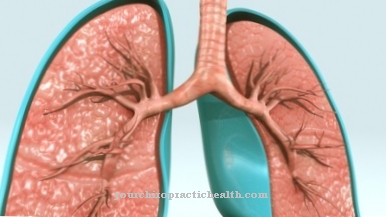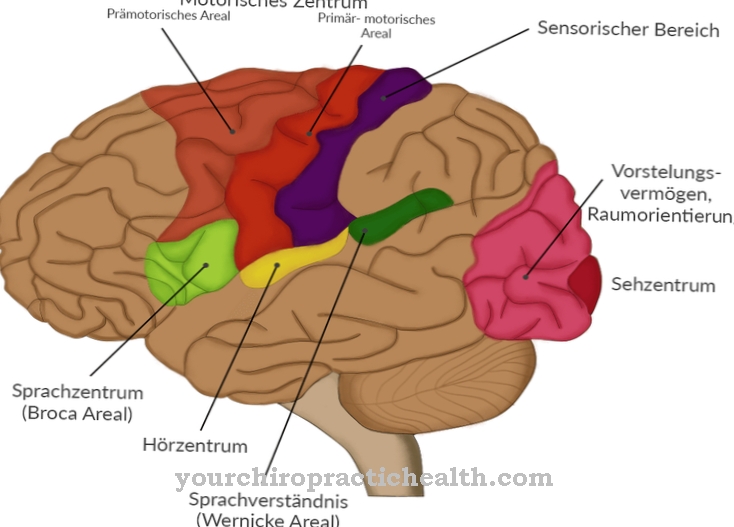Myotonia congenita Thomsen is a so-called hereditary disease; this is an over-excitability of the skeletal muscles. Myotonia congenita Thomsen is one of the hereditary diseases. The prognosis and the course of the disease are quite positive; severe restrictions, which significantly impair the quality of life, are not to be expected.
What is Myotonia congenita Thomsen?

© zvitaliy79 - stock.adobe.com
Under the name Myotonia congenita Thomsen the doctor describes the disruption of muscle functions - a myopathy.
Myotonia congenita Thomsen is a very rare disease (1 in 400,000) that is inherited as an autosomal dominant trait.
Myotonia occurs in the context of Myotonia congenita Thomsen. The muscle stiffness is characteristic of Myotonia congenita Thomsen.
causes
The formation of Myotonia congenita Thomsen is based on a genetic defect on chromosome 7, which codes for the chloride channels of the muscle fiber membrane. Due to the reduced chloride permeability, the muscle fibers become more easily depolarized.
The reason for such a mutation or change in the gene is not yet known. This also makes the treatment more difficult; In the case of Myotonia congenita Thomsen, care is mainly taken to ensure that the symptoms are alleviated. A treatment of the cause is not given according to the current state of knowledge.
Symptoms, ailments & signs
Those affected mainly complain of problems with their muscles. The first symptoms appear in childhood. However, the symptoms only develop with adulthood, so that in many cases Myotonia congenita Thomsen can only be detected after the age of 18. The person concerned complains of special mobility restrictions, so that he has problems with walking or certain movements.
Another characteristic is the muscle stiffness. The so-called myotonia can sometimes last for several minutes. A classic example is the handle on the door handle. The person concerned opens the door, but then cannot let go of the handle for several minutes because the muscles remain tense. Self-control or counteraction is not possible. Of course, the muscle suffers minor injuries due to the cramp. It can take several minutes, hours or days for the muscle to fully recover.
Diagnosis & course of disease
As part of the diagnosis, the doctor begins to study the patient's history.Due to the dominant inheritance of Myotonia congenita Thomsen, symptoms can be observed at an early stage. For this reason, it is advisable that relatives who are affected by Myotonia congenita Thomsen also accompany the diagnosis so that those people can answer any questions about the disease.
Especially in the case of genetic and inheritable diseases, it is important to always include family members who have inherited the genetic defect. However, if there is a spontaneous mutation, which means that there is no family background, the diagnosis is extremely difficult.
Another problem is that Myotonia congenita Thomsen cannot be diagnosed easily. Ultimately, there are no particular abnormalities; neither organs nor the chloride duct are affected by the defect. However, experienced doctors recognize that a gentle tap on a muscle is enough for it to immediately contract and a myotonic reaction to develop. While imaging tests or ultrasound examinations do not provide the desired information, electromyography can help with the diagnosis.
Electromyography can reveal an ion channel disorder. Genetic tests are carried out to ensure that it is actually Myotonia congenita Thomsen. Such tests can be used to detect the mutation. It is important that Myotonia congenita Becker can be excluded.
The prognosis for those affected with Myotonia congenita Thomsen is good. In almost all cases there is no impairment of the quality of life of the person affected. However, it only becomes problematic in the context of possible accidents at work if the muscle stiffness sets in during active activities; Because of those situations, the frequency of accidents is increased.
Complications
Due to the Myotonia congenita Thomsen, those affected suffer from considerable limitations and impairments in quality of life. There are severe disturbances in movement and coordination, so that normal everyday activities can usually no longer be carried out without further ado. Above all, walking and standing are usually no longer possible for the patient without further ado, so that the patients are dependent on the help of other people in their everyday lives.
The muscles in Myotonia congenita Thomsen are stiff and cannot be moved quickly. Uncontrolled movements of the patient can also occur. The muscles can also cramp, which can lead to very severe pain. It can take a few days for the muscles to recover from the strain. The myotonia congenita Thomsen does not heal itself.
A causal treatment of this disease is not possible. The symptoms can be limited and lessened through physiotherapy, although this does not lead to a completely positive course of the disease. In many cases, those affected must also avoid high levels of stress and strain so that the muscles do not suffer from symptoms.
When should you go to the doctor?
If children and adolescents repeatedly complain about muscle disorders, the symptoms should be monitored. The natural growth process often leads to confusion and the first signs of Myotonia congenita Thomsen are not sufficiently noticed. If the children complain more often about muscle or bone discomfort in direct comparison with their peers and experience them more intensely, the observations should be discussed with a doctor.
Low muscle strength, tension in the muscles even though they have been loosened, and restrictions on mobility should be examined and treated. Disturbances of the gripping function, unsteadiness of gait, the formation of bruises or bruises without external influence are signs of an existing illness.
If the symptoms persist over a longer period of time or if they increase in scope and intensity, a doctor's visit is recommended. If the locomotion can no longer be carried out on one's own, the myotonia congenita Thomsen is already at an advanced stage and must be examined by a doctor immediately.
If there are behavioral problems, if the child is very tearful or if participation in social life is refused, these are indications of an existing irregularity. If you can no longer take part in school sports lessons or if there are restrictions in leisure time activities, a doctor is required.
Therapy & Treatment
Due to the fact that Myotonia congenita Thomsen has a genetic background or the reason why this mutation occurs has not been clarified, only symptoms can be alleviated as part of the therapy. No treatment of the cause is required at all.
Due to the fact that myotonia is not a life-threatening disease and has no corresponding symptoms, any ordinary physiotherapy can help if the patient complains of increasing muscle stiffness. It is important that physiotherapeutic measures are taken regularly. In this way, the patient can train or relax his muscles and then take action against muscle stiffness.
It is advisable that the patient be informed about possible positive factors that can trigger myotonia. Cold, tiredness and stress should be avoided. Those factors can have an increased effect. However, warmth can help relieve symptoms that have already arisen. In many cases, those affected are also given medication, with the active ingredient primarily supporting the patient's ion channels.
Doctors mainly prescribe the active ingredients phenytoin or mexiletine. However, if the person concerned complains of only very weak symptoms, the medication can also be omitted; In the case of very minor complaints, physical therapy is ultimately sufficient. There are no surgical or other treatment options that can alleviate the symptoms or even fight the disease.
You can find your medication here
➔ Medicines for muscle painOutlook & forecast
The prospects for Myotonia congenita Thomsen are favorable. It rarely occurs. Statistically, one in 400,000 people is affected. Familial clusters are noticeable. This is because the Myotonia congenita Thomsen is passed on through the genes. The causes cannot currently be eliminated. It remains to be seen whether scientific research will develop suitable therapeutic approaches in the future. However, doctors can alleviate the symptoms so that a quality of life is maintained. The lifespan is not affected by the muscle disease.
Many patients learn in training units how to spend their everyday life with Myotonia congenita Thomsen. As a result, there are no significant disadvantages in many professions. Private life can also be mastered without outside help. In most cases, no drug treatment is even required. Mexiletine, among other things, is administered only rarely and if the course is severe.
The intensity of the symptoms is usually greater in men than in women. External factors such as temperature and the time of day can cause Myotonia congenita Thomsen as well as physical and psychological conditions that are difficult to associate with the disease.
prevention
Due to the fact that no cause is known for what reason Myotonia congenita Thomsen exists or it is a hereditary disease, no preventive measures are possible or known.
Aftercare
In most cases, the measures and options for follow-up care for Myotonia congenita Thomsen are clearly limited. The focus of this disease is therefore on early detection and treatment so that no further complications or other restrictions can arise. The person affected should therefore consult a doctor in good time and initiate treatment for the disease, as self-healing cannot occur.
In most cases with Myotonia congenita Thomsen it is necessary to take various medications in order to relieve the symptoms permanently and correctly. Those affected should observe the regular intake and the prescribed dosage in order to limit the symptoms. In many cases, physiotherapy and physiotherapy measures are also very important, with the patient being able to repeat and perform many of the exercises from these therapies at home.
The help and care provided by one's own family also has a very positive effect on the further course of the disease. This can also prevent depression and other psychological upsets. The disease itself does not usually reduce the life expectancy of the person affected.
You can do that yourself
Myotonia congenita Thomsen is a hereditary disease that must primarily be treated by a doctor. In addition to the medical treatment, the sick can begin various measures to accompany the therapy.
For example, activities such as exercising and changing your daily diet are effective. Strict personal hygiene is also important in order to alleviate the atrophies that typically occur. Furthermore, no unhealthy food or drinks such as fast food or alcohol may be consumed or drunk. The diet should be worked out in consultation with a nutritionist and the family doctor in order to be as effective as possible. In addition, exposure to the sun must be avoided. Especially in summer, the eyes need to be protected to avoid further damage.
The disabilities of the musculoskeletal system can be alleviated through exercises from yoga and physiotherapy, in addition to the physically prescribed physiotherapy. Sick people should also organize a handicapped-accessible facility or purchase walking aids and the like early on in order to compensate for falls and the resulting physical consequences. The doctor in charge can answer the detailed measures that make sense.






.jpg)

















.jpg)



